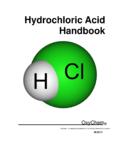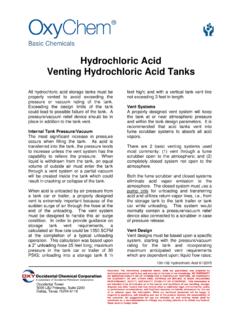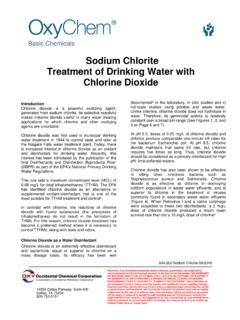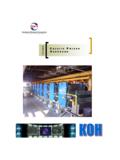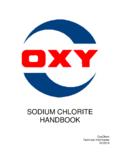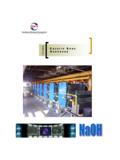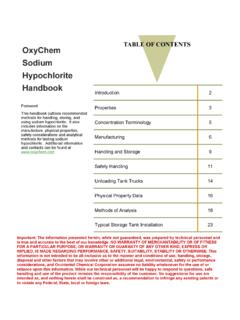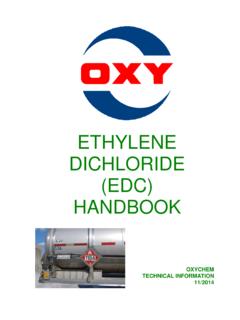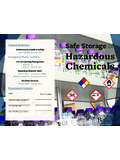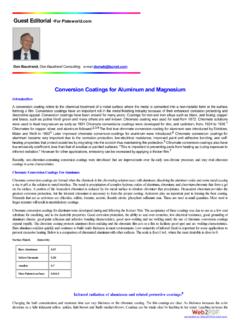Transcription of Sodium Chlorite Hydrogen Sulfide Control in …
1 Basic Chemicals Sodium Chlorite Hydrogen Sulfide Control in Wastewater Collection Systems Introduction mechanism for Sulfide formation. In the absence Hydrogen Sulfide (H2S) is a dense, colorless, of dissolved oxygen (DO) and in the presence of strongly odorous toxic gas that corrodes soluble Biological Oxygen Demand (BOD), infrastructures and impairs the performance of Desulfovibrio desulfuricans (SRB) and other wastewater treatment operations. sulfate-reducing bacteria (SRB's) convert the sulfate ion to Sulfide . Hydrogen Sulfide is naturally converted to sulfuric acid which is corrosive towards steel and Anaerobic concrete.
2 Control of H2S will result in increased Microorganisms 2- life and lower maintenance cost for facilities and SO4 + Organic matter (no ) H2S + CO2. piping. In addition, worker safety is of concern as Hydrogen Sulfide is extremely toxic at levels above 500 ppm, which can be reached in Hydrogen Sulfide formation in wastewater confined spaces. systems occurs primarily in the gelatinous slime layer that accumulates on pipe walls and in the A number of Sulfide Control strategies are sludge blankets of clarifiers and other solids available depending on the system design and processing units. The rate of Sulfide production treatment goal.
3 Is dependent upon the concentrations of sulfate ions, organic matter, and dissolved oxygen, as Application Description well as other factors such as pH, temperature, Sulfide exists in wastewater in three forms; retention time, stream velocity, and surface Hydrogen Sulfide gas (H2S), non-volatile ionic area. - 2- species Hydrogen Sulfide (HS ) and Sulfide (S ). - The ratio of each of the three species H 2S, HS Treatment Alternatives 2- and S is dependent on the pH. At pH 6, 90% There are two basic ways to Control Hydrogen of the Sulfide will be present as H2S, and the Sulfide : higher the H2S concentration the greater the Prevent Sulfide formation tendency for it to volatilize.
4 Conversely at pH Remove the Sulfide after its formed 2- 10, 100% of the Sulfide will be present as S . Preventing Sulfide Formation Hydrogen Sulfide occurs naturally through the Inhibiting bacterial action or moderating the anaerobic decay of organic matter and is variables affecting Hydrogen Sulfide generation recognized by its characteristic rotten egg odor. is often the basis for controlling Hydrogen Sulfide In typical domestic wastewater, microbial in wastewater treatment systems. Treatment reduction of the sulfate ion is the dominant options include the following chemicals. 642-402 Sodium Chlorite 12/2014.
5 Important: The information presented herein, while not guaranteed, was prepared by technical personnel and is true and accurate to the best of our knowledge. NO WARRANTY. OF MERCHANTABILITY OR OF FITNESS FOR A PARTICULAR PURPOSE, OR WARRANTY. OR GUARANTY OF ANY OTHER KIND, EXPRESS OR IMPLIED, IS MADE REGARDING. PERFORMANCE, SAFETY, SUITABILITY, STABILITY OR OTHERWISE. This information is Occidental Tower not intended to be all-inclusive as to the manner and conditions of use, handling, storage, disposal and other factors that may involve other or additional legal, environmental, safety 5005 LBJ Freeway, Suite 2200 or performance considerations, and OxyChem assumes no liability whatsoever for the use Dallas, Texas 75244-6119 of or reliance upon this information.
6 While our technical personnel will be happy to respond to questions, safe handling and use of the product remains the responsibility of the customer. No suggestions for use are intended as, and nothing herein shall be construed as, a recommendation to infringe any existing patents or to violate any Federal, State, local or foreign laws.. Basic Chemicals Hydrogen peroxide Chlorine dioxide Sodium or calcium nitrate Nitrate Iron salts Chlorine dioxide (ClO2) is applied at or near Sodium Chlorite (NaClO2) is applied at or near the source of Hydrogen Sulfide . Chlorine the source of Hydrogen Sulfide . It is also applied dioxide, when fed at doses higher than the in wastewater systems where a retention time of minimum required to destroy Hydrogen Sulfide greater than 3 hours is encountered, such as will remove the biofilm layer, which contains the remote sites for long duration Control .
7 Sodium bacteria creating the Sulfide . Chlorine dioxide Chlorite selectively oxidizes Sulfide and related reacts more rapidly and completely than other organic odors. Unlike hypochlorite, Sodium available oxidizers and does not form colloidal Chlorite does not react with ammonia, and does sulfur. not form chlorinated organics. 0. Sodium nitrate (NaNO3) is applied to retard 2H2S + NaClO2 2S + 2H2O + NaCl septicity and promote bio-oxidation of organic odors in systems with a retention time greater Typical field applications require a minimum of 3. than four hours. Sodium nitrate is a biological mg/L of Sodium Chlorite per 1 mg/L of Sulfide .
8 Approach to controlling odors in wastewater, providing naturally occurring facultative Hydrogen peroxide (H2O2) is applied to the anaerobic denitrifying bacteria with a source of wastewater system usually where there is a bound oxygen which is metabolized retention time of less than 5 hours and at least preferentially over other sources of oxygen like 30 minutes prior to the point where the Hydrogen sulfate. This results in the production of nitrogen Sulfide is released. Hydrogen peroxide is a - gas via intermediates like nitrite (NO2 ), nitric stronger oxidant than either chlorine or oxide (NO), nitrous oxide (N2O) and other potassium permanganate.
9 Hydrogen peroxide metabolic byproducts rather than Sulfide . will oxidize the Hydrogen Sulfide present and Anaerobic promote bio-oxidation of organic odors. - BOD + NO3 Microorganisms N2 + CO2 + Biomass Hydrogen peroxide decomposes into oxygen (no ) and water, environmentally harmless Typical field applications require a minimum of byproducts. pounds of nitrogen-oxygen (N-O) per pound 0. of BOD. H2S + H2O2 S + 2H2O (pH < ). Removing Sulfide After its Formation 2- H2S + 4H2O2 SO4 + 2H2O (pH > ). Removing the Sulfide after it has been formed can be achieved using a variety of chemicals Typical field applications require 1 to 3 mg/L.
10 Either alone or in combination. The treatment Hydrogen peroxide per 1 mg/L Sulfide . The mechanism generally employed is oxidation of reaction with Sulfide is rapid with 90% of the the Hydrogen Sulfide to either sulfur or the Hydrogen peroxide typically consumed within 10. sulfate ion. In some cases, the chemical to 15 minutes. treatment program also promotes bio-oxidation of organic odors. Common treatment options Nitrate (NO3) may also be effective for the include: removal of existing Sulfide in the presence of bacteria that can utilize the nitrate for the Sodium Chlorite oxidation of Sulfide to 642-402 Sodium Chlorite 12/2014.
